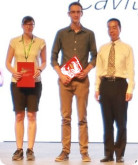Accelerator Physics
The University of Victoria is a founding member of TRIUMF and has a long standing tradition in accelerator physics. TRIUMF accelerators are the heart of the Canadian accelerator-based experimental subatomic physics program, both because they enable on-site world-class research in nuclear physics and material sciences (CMMS), and because TRIUMF’s expertise allows Canada to make significant in-kind contributions to off-site international accelerator projects thus enabling participation in experiments at those facilities.
Currently six TRIUMF accelerator physicists are members of the UVic adjunct faculty. All of them have active research programs with opportunities for new graduate students in the following areas:
- Superconducting Radiofrequency Cavity Developments and fundamental material research (R. Laxdal)
- Targets and Ion Sources developments (A. Gottberg, T. Day Goodacre)
- Beam Physics (O. Kester, R. Baartman, T. Planche)
Research into ion sources and low energy accelerators is performed with our industry partner D-Pace lead by their Founder and Chief Science & Innovation Officer M. Dehnel who is also an adjunct professor at UVic.
While UVic has no particle accelerators on site we perform research on site in the following areas
- Cryocooler based fundamental superconducting radiofrequency studies (T. Junginger)
- Surface and Materiel Science Studies at the Advanced Microscopy Facility (A. Blackburn, T. Junginger)
- Application of SRF technology to quantum computing (R. de Sousa, T. Junginger)
- Beam Dynamics studies for SuperKEKB (M. Roney)
More information on research topics and the graduate program in accelerator physics can be found here.
RESEARCH HIGHLIGHTS
ARIEL Project
The University of Victoria is the lead University of the ARIEL project under construction at TRIUMF since 2011.

The primary mission of ARIEL is to deliver unprecedented intensities of rare, short-lived exotic isotopes, and in particular those with extreme neutron excess, to simultaneous and multiple experiments, at the existing and world-leading ISAC accelerator complex. A secondary mission of ARIEL is to anticipate future uses of e-linac technologies such as free electron lasers, and including commercial uses such as the production of medical isotopes by photo-fission.
The flagship of the ARIEL project is a high power superconducting electron linear accelerator to be used as a photo-fission driver. Our group completed the design and construction of 17 beam diagnostic units that measure the beam profile along the length of the new accelerator. The photo below shows team members with the view screen camera units during construction.
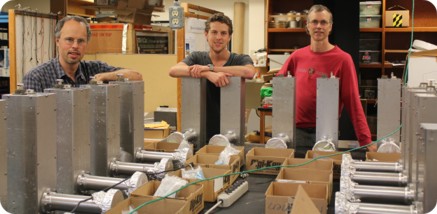
Novel Deflecting Mode Cavity for ERL Application (R. Laxdal and D. Karlen)
TRIUMF/UVic student, Doug Storey, completed his PhD project on the design and fabrication of a 650MHz superconducting RF deflecting cavity. The cavity will find future use in the ARIEL e-linac to allow simultaneous operation as an energy recovery linac (ERL) for THz and IR applications while allowing delivery of driver beams to the ARIEL production targets. The deflector cavity was fabricated in house at TRIUMF using novel fabrication techniques. The cavity exceeded the performance requirements in cryogenic tests. Doug Storey received the best student poster prize during a competition with his peers at the SRF2017 conference in Lanzhou China. The research provides an avenue for reducing costs of SRF resonators and introduces a new compact variant to the family of deflecting mode cavities.
Combined FLASH and Microbeam Radiotherapy using the ARIEL e-linac (A. Gottberg and M. Bazalova Carter)
Radiation therapy, one of the three main treatment options of cancer patients, is not only known for its benefits, but reveals also negative side effects of damages to healthy tissue. To reduce side effects a combination of two novel treatment techniques, the ultra-fast (FLASH) radiotherapy and the spatially fractionated microbeam therapy (MRT) is being explored. The ARIEL electron linac driven electron-to-gamma converter reaches unprecedented gamma power densities and allows to study the FLASH irradiation effect combined with a microbeam. Compared to conventional radiotherapy ARIEL delivers a 1000 times higher dose rate in a single shot in a 100 times smaller beam spot (sub mm).
SUPERCONDUCTING RADIOFREQUENCY MATERIALS AND CAVITIES (R. Laxdal and T. Junginger)
SRF cavities are the enabling building blocks of state of the art particle accelerators. Typically, superconducting accelerating cavities are formed and welded from high purity Niobium a weak Type-II superconductor with a critical temperature of 9.2K. Performance is gauged by the rf surface resistance at the operating point that determines the cryogenic load and the peak accelerating fields that are the chief cost drivers of modern linear accelerators.
The legacy from the development of the superconducting ISAC-II heavy ion linear accelerator and ARIEL electron linac is an SRF facility, unique in Canada, with clean room, high pressure water rinse facility, chemical etching facility, test cryostats and rf equipment to allow the processing and testing of superconducting resonators from 100MHz to 1.3GHz and from temperatures from 1.6K to 4.4K. The lab supports the in house accelerator program, external collaborations as well as SRF research and, through NSERC funds, a varied student program. In addition TRIUMF houses two state of the art material science diagnostic centres in muSR and beta-NMR that can give critical insight into performance of materials in the superconducting state. UVic has a complimentary set of tools to augment the TRIUMF infrastructure such as the Advanced Microscopy Facility.
Studies to optimize and understand rf performance have been focused primarily on elliptical 1.3GHz cavities for electron acceleration. Significant advances have been made recently in using heat treatments including doping to optimize / manipulate the near surface (100nm depth) where rf currents flow to reduce the surface resistance of niobium and/or for pushing the high field limit. A new wave of hadron SRF linear accelerators are being developed globally (FRIB, PIP-II, RAON, ESS) that would operate with continuous wave (cw) rf power. The cavities for hadron accelerators are non-elliptical structures utilizing the TEM accelerating mode and must accelerate a wide range of particle velocities from 5% to ~70% the speed of light and with rf frequencies ranging from 100MHz to 700MHz typically.
Our research primarily focusses on developing a better understanding of the loss mechanisms and in enhancing the performance of TEM mode cavities for hadron acceleration. Our work has convinced us that pushing performance limits requires the ability to study both the microscopic behaviour of materials as well as the performance of full resonator structures.
SRF Materials Research
Demands for higher energy and more efficient linear accelerators have strained the capabilities of niobium close to its fundamental limits. Several routes have been proposed using thin film novel superconductors (e.g. Nb3Sn), alternating nanometer thin layers of superconductors and insulators and nitrogen doped niobium. In all cases, the goal is to sustain the Meissner state (vortex-free superconducting state) at a higher field compared to bulk Nb technology. Theoretical studies have suggested that the interface between the layered structure provides an additional energy barrier for flux penetration as well as recovering the stability of the order parameter near defects via the proximity effect. Elucidating the mechanism and effectiveness of layered superconductors will require probing the local magnetic phase at each layer near the interface.
Sample studies with DC methods can allow a quicker and more accurate measurement of the fundamental limiting field without being affected by RF surface conditions and without building entire cavities. One powerful technique is to measure the local magnetic field via beta-decay asymmetry, which is correlated with the nuclear spin of the probe (muon or radioactive spin-polarized ion beam). At TRIUMF, two independent experimental stations exist, one utilizing muon spin resonance/rotation (muSR) and one using beta-NMR techniques. muSR has been used by the SRF group to characterize the strength of the superconducting state of treated Nb and new materials like Nb3Sn and MgB2. Recently we have shown, in muSR studies, that an additional thin surface coating of higher Tc superconductor can suppress flux penetration to the Niobium underlayer. The role of the overlayer is not fully understood but it may be that local depressions in the order parameter of the substrate that would serve as flux entry locations are mitigated through the proximity effect by the coating. In beta-NMR electrostatic deceleration is used to control the depth of implanted polarized 8Li ions, typically in the range of 2 - 300 nm perfectly suited to probe magnetism through the London penetration depth or through layered systems. A new beta-NMR spectrometer named beta-SRF, funded with an NSERC RTI, provides a new capability unique in the world to apply a field up to 200mT parallel to the surface of the sample, and thus offers a sensitive new way to probe the near surface properties of Nb used in SRF cavities beyond the superheating field of Nb.
SRF Cavities Research
Our program of full resonators study will focus mainly on optimizing the performance of nonelliptical coaxial cavities (TEM) for hadron (protons and ions) acceleration. To date the world has focused primarily on 1.3GHz cavities. To increase the energy of the beam in the velocity regime up to beta=0.7 these accelerators use different types of coaxial SRF cavities, such as quarter-wave resonators (QWR) and half-wave resonators (HWR) at frequencies ranging from 80 to 700MHz. As these SRF cavities are typically cooled with liquid helium at temperatures between 2.0 and 4.2K, the RF losses in the cavity walls are a major cost factor in capital investment and in operating budget for the cryoplant and its infrastructure. We intend to shed light on the role of geometry, rf frequency and rf field on TEM cavity performance and processing.
There are four chief questions that are at the core of this research. Firstly the recent improvements from doping in 1.3GHz cavities need deeper understanding both at a fundamental level and practically to allow optimization. In particular the high field performance of the doped cavities needs understanding and refinement. Secondly the role of rf frequency and operating temperature is not well understood and a better understanding is crucial to drive optimization. Thirdly, the improvement at 1.3GHz from heat treatments including doping needs extending to lower frequencies to shed further light on the mechanism. Fourthly the TEM mode geometry needs further exploration to understand and optimize the role of cooldown and flux expulsion.
To optimize these types of cavities for future accelerator facilities TRIUMF has developed and built two coaxial test cavities, a QWR and an HWR. The cavities can be excited at their fundamental mode (200 and 400MHz respectively) but also at higher harmonics within the same test cycle and reach an unprecedented parameter space to study loss mechanism in detail. To test and optimize surface and heat treatments an etching lab and an induction furnace are available. The ability to expel flux is important to reach lowest cryogenic losses. The TRIUMF cryostat is equipped with Helmholtz coils to allow canceling or augmenting the residual magnetic field for extensive flux expulsion studies of the TEM geometry for different material prepartions.
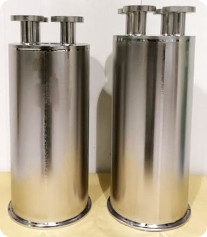
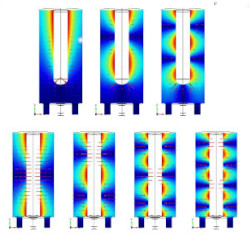
Left: Coaxial Test cavities to optimize heavy-ion accelerators. Right: Surface magnetic fields of the quarter wave (top) and half resonator (bottom) in different modes.
In addition to understanding fundamental limitation of TEM mode geometries the SRF research also can develop new cavity shapes for particular application. Recently TRIUMF has developed a new variant of the single spoke resonator (SSR) for the RAON project in Korea. The new cavity variant eliminates multipactoring that has plagued standard SSR designs.
TARGET AND ION SOURCE DEVELOPMENTS (A. Gottberg, T. Day Goodacre)
The most important figures of merit of a radioactive beam facility such as TRIUMF-ISAC and TRIUMF-ARIEL are availability, intensity, purity and reliability of short-lived isotopes. While new and upgraded facilities often focus on increasing isotope production rates, the delivered isotope beam intensity is often determined by loss factors of up to a million due to nuclear decay in the processes of extracting the short-lived species from the target material. Further losses occur during the ionization and extraction process, often outweighing the gains achieved through costly and technically challenging driver beam power upgrades.

UVic students are making significant progress in the fields of fundamental target ion source development, including isotope production, target material synthesis, ionization and isotope beam extraction.
One MSc project focussed on the development of a high-power electron-to-gamma ray converter. As an unprecedented methodology for the production of rare isotope beams, ARIEL exploits high-intensity gamma ray-induced nuclear reactions, most notably photo-fission reactions in actinide target materials. A system capable of accepting 100 kW, 35 MeV electron beam has been developed. At the heart of the new technology is an explosion bonded tantalum-aluminum composite that has been conceived and successfully validated at representative electron beam power density.
As part of another MSc project, the ARIEL isotope ion beam extraction system has been modeled using multi-physics particle tracking simulations. The understanding of the fundamental plasma effects in so called FEBIAD ion sources if crucial importance for the conversation of rare isotope atoms into ions and the subsequent beam formation.
In the field of target material development, M.S. Cervantes has studied the synthesis of multiphasic uranium mixed carbides which is the reference material for ISOL-type targets world-wide. At the ISAC facility, this material is highly requested and used, especially for the production of neutron-rich fission fragments as well as for neutron-deficient heavy spallation products. Previously, the production of this material had been demanding on personnel as well as technical infrastructure, making both unavailable for the critical development of actinide target materials for the ARIEL facility. We now have an in-depth understanding of this demanding functional material. This has allowed the synthesis of this material to be optimized, reducing the time required ten-fold and improving the quality and reproducibility of the final material.
BEAM PHYSICS (O. Kester and R. Baartman)
Development of automatic tuning applications
Beam physics codes are used to design accelerators, beam preparation and beam transport systems like charge state breeders for instance. Most beam physics models are based on the particle tracking technique which requires calculating individual particle trajectories for different starting positions in phase space. Especially for high current accelerators this technique becomes time intensive. A code developed at TRIUMF by Rick Baartman describes the beam envelope throughout the entire accelerator instead of individuals particles. Based on this code UVic students Olivier Shelbaya and Spencer Kiy develop automatic tuning applications (High level application – HLA) for the ISAC accelerator.

Electron and ion sources
Aside the beam physics of particle accelerators, the basic understanding of beam production using high charge state ions sources, both the Electron Cyclotron Resonance Ion Sources (ECRIS) and the Electron Beam Ion Sources (EBIS), is a very active research field at TRIUMF. Joseph Adegun is working on the optimization of an ECRIS charge state breeder used to convert singly charged ions to highly charged ions prior to further post acceleration. He addresses the injection of singly charged ions into the ECRIS, the plasma parameter for the charge conversion and the extraction system. To benchmark these simulations model base beam tuning and HLAs are required, which allow for interesting hands on student studies with ion source devices.
High brightness electron guns are fundamental for rare isotope production using photo-fission, both for the ARIEL superconducting electron linac and for the new ARIEL charge state breeder based on an Electron Beam Ion Source (EBIS). Both electron gun systems are state of the art systems, which require systematic investigations to optimize beam quality and intensity.
The electron linac 300 keV electron gun is a grid based thermionic gun that delivers up to 10 mA of electron beam current. As no ultimate brightness was required, the grid driven concept is well suited for the e-linac beam injection. For the HV operation, the gun employs a novel layout in which the anode penetrates the HV chamber mounted in a long anode tube, which minimizes the surface area that exposes the negative HV, reducing the likelihood of field emission. The use of the long anode tube requires a strong and compact solenoid to capture the e-beam after beam formation provided by the gun diode electrode geometry.
The gun grid voltage is modulated at 650 MHz, producing short bunches obviating the need for a chopper and beam dump, an important move taking the 3kW e-beam power into account. The gun modulation scheme is novel and avoids placing the 650 MHz amplifier and macro-pulser on a high voltage platform alongside the gun. Instead, the RF power is transmitted via a dielectric (ceramic) waveguide between the grounded vessel and the gun. However, the gun design using a grid, has impact on the beam formation in terms of reduced beam quality and halo formation. The electron gun is operated like a triode with similar characteristics. With the negative cathode bias, the bunch charge and length can be adjusted by the grid bias voltage and the rf-amplitude. Any emission of electrons from the grid can lead to an uncontrolled increase of the beam power delivered by the electron linac, as no chopper is included in the low energy beam transport section (LEBT).
POLARIZED BEAMS for SuperKEKB (M. Roney)
SuperKEKB is the electron-positron asymmetric collider at KEK operating at a centre-of-mass energy of 10.58GeV. SuperKEKB beams are unpolarised, but as pointed out in the SuperB Conceptual Design Report (CDR), such an e+e- collider with polarized electrons would enable a new electroweak physics program. This upgrade requires a Compton polarimeter and spin rotators. Due to space constraints in the SuperKEKB accelerator the spin roatator may need to be realized by a combined function magnet enabling steering and spin rotation simultaneously. UVIC students and faculty are developing the design requirements for both systems. Beam dynamic studies are carried out for full integration of the combined function magnets with minimal loss in polarization and luminosity.
DESIGN OF A COMPACT NEUTRON SOURCE (R. Laxdal and A. Gottberg)
Neutron beams are an essential part of the 21st century toolkit for the science and engineering of materials. Common applications of neutron beams include the study of new materials for energy and information technologies, of light-weighting technology for critical parts in cars and airplanes, and the study of biomolecules in our own bodies with implications for maintaining health or treating disease. Following the closure of the National Research Universal (NRU) reactor at Chalk River in March 2018, Canada now has no high intensity neutron source and no national user facility for neutron beam research. To address this issue we are exploring the technical design requirements for a Compact Accelerator-based Neutron Source (CANS). A CANS consists of four major components: (1) a proton accelerator, (2) the target for the proton beam that acts as a proton-to-neutron converter, (3) a neutron moderator, and (4) neutron beamlines leading to instruments for research or industrial use.
NEGATIVE ION PRODUCTION AT D-PACE (M. Dehnel)
UVic graduate students have the opportunity to perform research on ion sources and electrostatic accelerators thanks to a collabration with the Canadian accelerator technology company D-Pace. One MSc project is exploring the creation of negative ions via a charge exchange process by passing an H¯ beam from a TRIUMF licensed volume-cusp source through non-metallic neutral vapours. Any negative ions that are formed through the charge transfer between the incident H¯ and neutral vapours or gases will be extracted and accelerated to tens of keV using a custom in-vacuo electrostatic accelerator. The purpose of this research is to explore new methods for accelerated negative ion beam production which could lead to advancements in discovery science. Industrial applications could also arise from this project as many industries are reliant on alkali or alkaline earth metal vapours for negative ion beam production through charge transfer which are found to be contaminants and cause significant maintenance issues.
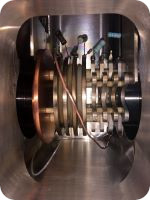
Electrostatic-accelerator with neutral gas injection cavity for charge-exchange developed by Andrew Paul in the framework of his MSc work.
Faculty
Adjunct Faculty
- Rick Baartman
- Thomas Day Goodacre
- Morgan Dehnel
- Alexander Gottberg
- Oliver Kester
- Bob Laxdal
- Thomas Planche
Current Graduate Students
- Mina Abbaslou
- Joe Adegun
- Asad Asaduzzaman
- Ferran Boix Pamies
- Marla Cervantes
- Sundeep Gosh
- Ruth Gregory
- Daniel Hedji
- Paul Jung
- Spencer Kiy
- Aveen Mahoon
- Mattias McMullen
- Andrew Paul
- Noah Teesema
- Lucas Wallace
Alumni
- Doug Storey
- Kyle Gao
- Yuhao Peng
- Fernando Maldonado
- Olivier Shelbaya
- June 2023 - Congratulations to Adedapo Joseph Adegun who has succesfully defended his PhD thesis "Improvement of the Efficiency and Beam Quality of the TRIUMF Charge State Booster”. He will continue working at TRIUMF as a PostDoc to further improve the charge state booster. -
- April 2023 - PhD student Aveen Mahoon has received a prestigious doctoral NSERC Postgraduate Scholarship for her work on eliminating dust in superconducting radiofrequency cavities with Thomas Planche. Congratulations Aveen!
- January 2023 - Olivier Shelbya has succesfully defended his PhD thesis “Model Coupled Accelerator Tuning” - Congratulations Dr. Shelbaya!
PhD Thesis project on PIC-MCC modeling of low-temperature plasmas with an emphasis on improving the understanding of the plasma behavior of ion sources for industrial applications at D-Pace
The PhD student will work on upgrading an existing 2D/3D Particle-In-Cell (PIC) code (developed in house) in order to simulate the plasma of ion sources. The PIC algorithm is parallelized and can run efficiently on supercomputers. It is explicit and electrostatic and up to 3-dimensions in space and 3-velocities. It is a model targeted to study the behavior of low-temperature plasmas; it can implement an arbitrary physical-chemistry to simulate the effect of collisions between charged particles and the gas and has a total flexibility on the design of the geometry of the plasma source including the possibility to add extraction apertures. Due to the nature of the algorithm, which is explicit, the simulations at high density will be performed, with no loss of generality in quiescent plasmas, with a scaling of the vacuum permittivity.
The PhD candidate’s work will be two-fold: (1) to upgrade the model to include a filament and an RF-antenna to couple the external power to the plasma. The former emits electrons which are accelerated by the plasma sheath and hence enter the quasi-neutral plasma with a high kinetic energy (typically 100’s of electron-volts). These electrons ionize the gas and generate the plasma. The latter corresponds to the absorption and redistribution of RF power by plasma electrons though the RF electric field. The student will design a filament numerically in 2D and 3D and will implement Maxwell’s equations for the RF case (reduced to a Poisson like equation for the vector potential). Lastly Coulomb collisions will be programmed to include the Maxwellianization process of the latter which is important when the electron source term is a beam (as in the case of a filament). (2) The second aspect of the thesis will be to perform a comprehensive physics analysis comparing the simulated plasmas with the experiments. The latter will be performed on the plasma sources at D-Pace.
Concerning the physics studies. We will focus on a source producing negative ions and compare the effect of the use of a filament or an RF antenna on the plasma properties. An RF antenna seems to produce fast positive ions which might induce sputtering of the wall material (because the plasma potential is higher than with filaments as a source). This is currently an engineering issue and an open-problem for the design of a RF-driven source. The student will work on a solution to mitigate or cancel out this issue (biased electrode, etc.). Other important physics questions such as the difference between hydrogen and deuterium gas in the production yield of negative ions will be studied. Lastly, large scale rotating plasma instabilities in Penning discharges will be studied to assess, if they indeed exist in the conditions of the experiment, what would be their incidence on the beam of particles which are extracted from these sources. A Penning discharge consist of a long tube with a magnetic field aligned with the latter and electrodes short-circuiting the field lines. Electrons are magnetized (and hence confined inside the source volume) while ions might be either somewhat magnetized or not.
In conclusion this thesis project will be devoted to numerical programming of a Particle-In-Cell algorithm, physics studies of two plasma sources and comparison with experiments. The PhD candidate must have a good knowledge of plasma physics and programming skills. The PIC code is written in Fortran 90 and parallelized with MPI and OpenMP. Experiments will be performed at D-Pace.
- McFadden, R.M., Asaduzzaman, M., Prokscha, T., Salman, Z., Suter, A. and Junginger, T., 2023. Depth-resolved measurements of the Meissner screening profile in surface-treated Nb. Physical Review Applied, 19(4), p.044018.
- Gorgichuk, N., Junginger, T. and de Sousa, R., 2023. Modeling Dielectric Loss in Superconducting Resonators: Evidence for Interacting Atomic Two-Level Systems at the Nb/Oxide Interface. Physical Review Applied, 19(2), p.024006.
- Thoeng, E., McFadden, R.M., Saminathan, S., Morris, G.D., Kolb, P., Matheson, B., Asaduzzaman, M., Baartman, R., Dunsiger, S.R., Fujimoto, D. Junginger, T., and Laxdal R.E. 2023. A new high parallel-field spectrometer at TRIUMF’s β-NMR facility. Review of Scientific Instruments, 94(2), p.023305.
- Turner, D.A., Burt, G. and Junginger, T., 2022. No interface energy barrier and increased surface pinning in low temperature baked niobium. Scientific Reports, 12(1), p.5522.
- Jung, P.M., Planche, T. and Baartman, R., 2022. Hybrid macroparticle algorithm for modeling space charge. Physical Review Accelerators and Beams, 25(8), p.084602
- Shelbaya, O, Angus, T, Baartman, R., Jung, P.M., Kester, O., Kiy, S., Planche, T. and Raedel, S.D. 2021. Autofocusing drift tube envelopes. Phys. Rev. Accel. Beams 24, 124602


